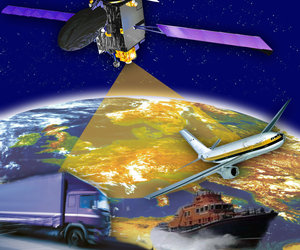End of test bed marks a new era for EGNOS
Another developmental milestone has been reached for EGNOS (European Geostationary Navigation Overlay Service), with the transition from ESA’s EGNOS System Test Bed to the ‘production’ EGNOS system for provision of GPS augmentation services over Europe.
The first European satellite navigation system, EGNOS, a joint project of ESA, the European Commission and Eurocontrol, has discontinued what was known as the EGNOS System Test Bed (ESTB). EGNOS is now making use of its operational network to provide signals to the European user community for navigation, positioning and timing with an improved utilisation of the GPS system.
For the last six years, the ESTB improved the application of navigation, positioning and timing services in a multitude of fields such as farming, aviation and maritime tests, road applications, and many others. By doing this, ESTB made significant preparations for the coming era, where the completed EGNOS system will serve Europe in a fully operational and commercial mode, later also co-operating with the Galileo system.
The EGNOS System Test Bed was a reduced version of EGNOS using experimental monitoring stations and processing centres. Its development was financed by ESA Member States with contributions from the European Commission and carried out under ESA management with major participation by European industry, notably Alcatel Alenia Space (France), GMV Sistemas (Spain), Thales (UK), the German Aerospace Centre (Deutsches Zentrum für Luft- und Raumfahrt – DLR) and Kongsberg-Seatex (Norway).
The first signal started in February 2000, providing opportunities for validating new application developments in a realistic environment. The experimental signals from the ESTB also had the purpose of helping navigation equipment manufacturers and application developers to test their products and allowing users to familiarise themselves with the system. The ESTB even allowed testing expansions of the EGNOS system outside Europe.

Many premieres can be attributed to the EGNOS System Test Bed – from the first European navigation signal in space to the first joint European-Chinese demonstration on the Yangtze River, not forgetting the first EGNOS guided flight across the African continent.
The ESTB included a space segment of two transponders aboard the Inmarsat-III satellites, a ground segment with a number of reference monitoring stations throughout Europe and beyond, and two processing centres. One processing centre was located at the premises of the French Space Agency (Centre National d'Etudes Spatiales – CNES) in Toulouse, France, where data archiving, post-processing and uplink to the Geo satellites was also undertaken. The other was hosted by the Norwegian Mapping Authority at its centre in Hönefoss, Norway. Web-site based real-time access to the outputs of the ESTB was also available from ESA’s Navigation Laboratory at ESTEC, in Noordwijk, The Netherlands. The navigation laboratory hosted a dedicated server, known as SISNeT, which provided the user community with navigation data via the internet.
The ESTB signal focused mainly on accuracy and, therefore, did not provide the availability and integrity data that EGNOS will provide but was a great tool for expanding the expertise and know-how relating to satellite navigation in Europe and preparing for future developments leading to Galileo.
EGNOS, whose first signal in space was transmitted in 2003, and which grew in parallel with the test bed, consists today of a network of around 40 ground stations distributed throughout Europe and designed to record, adjust and improve data from the American GPS system. The modified signals are relayed by geostationary satellites to the receivers of system users. In contrast to the 15-20 metre accuracy offered by GPS, the European system is accurate to less than two metres and unlike GPS, which is a military system, the European version offers guaranteed signal quality.
The EGNOS story goes on, enriched by the valuable experience from ESTB, allowing Europe to provide improved positioning services.















 Germany
Germany
 Austria
Austria
 Belgium
Belgium
 Denmark
Denmark
 Spain
Spain
 Estonia
Estonia
 Finland
Finland
 France
France
 Greece
Greece
 Hungary
Hungary
 Ireland
Ireland
 Italy
Italy
 Luxembourg
Luxembourg
 Norway
Norway
 The Netherlands
The Netherlands
 Poland
Poland
 Portugal
Portugal
 Czechia
Czechia
 Romania
Romania
 United Kingdom
United Kingdom
 Slovenia
Slovenia
 Sweden
Sweden
 Switzerland
Switzerland




























